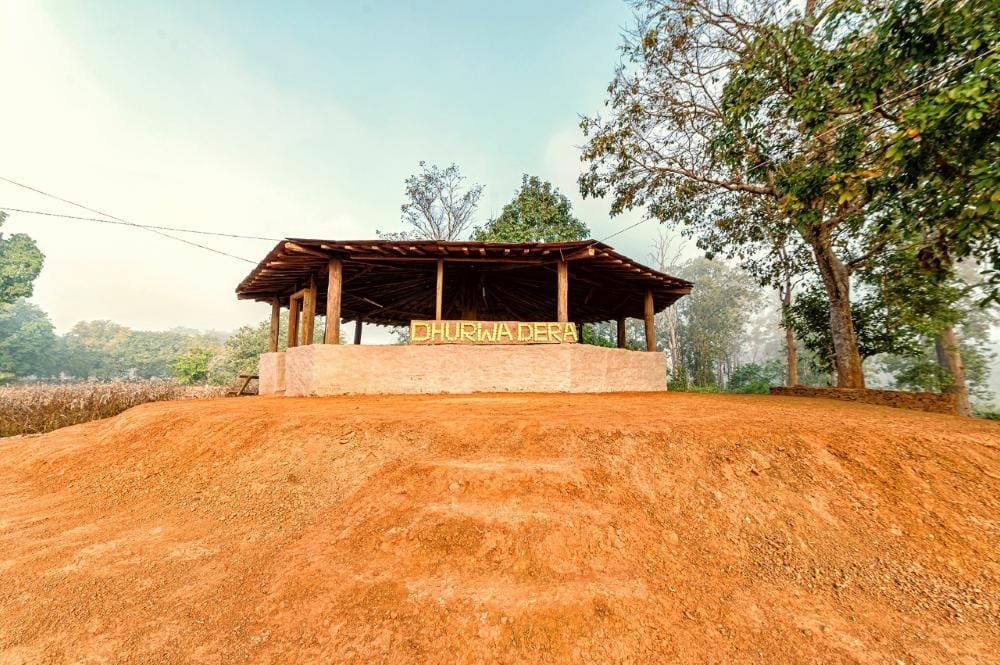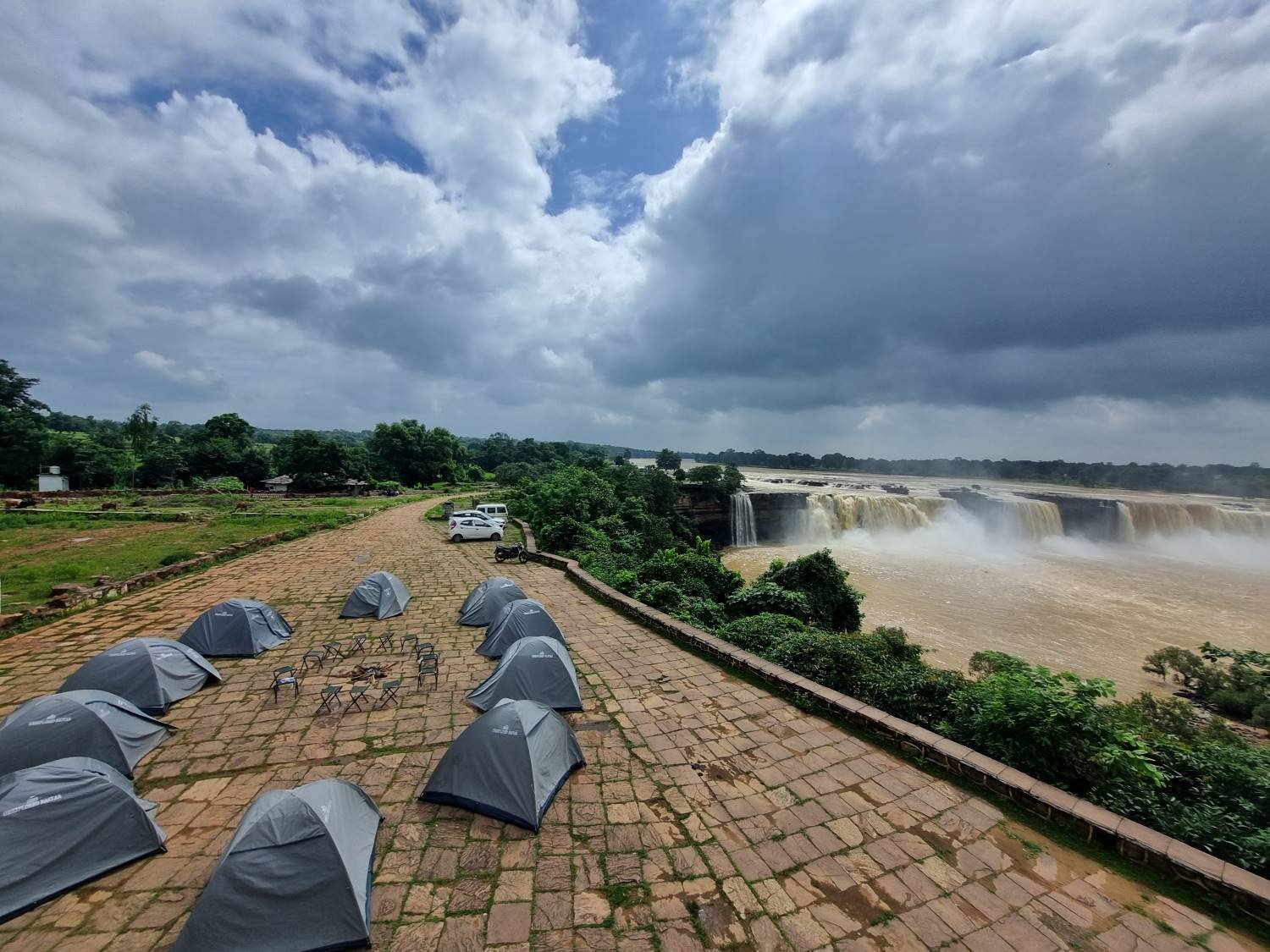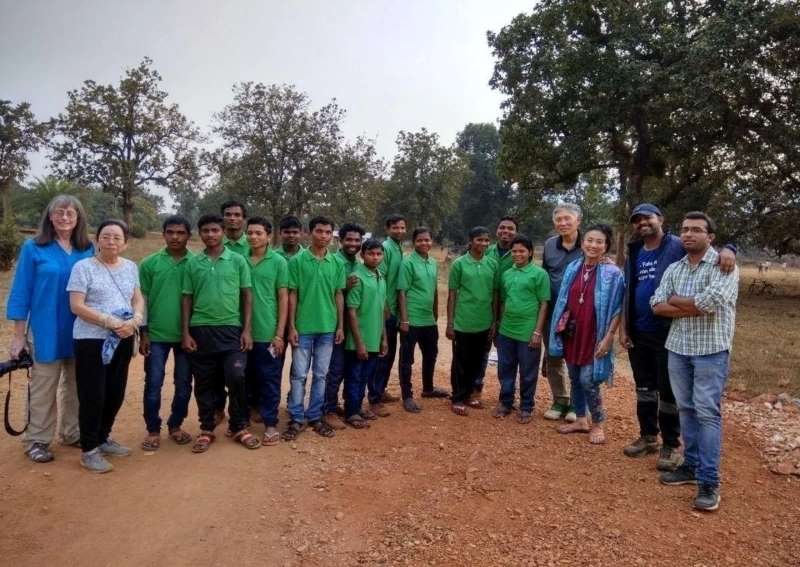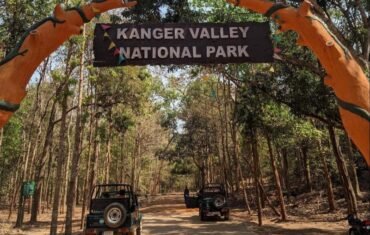Clock-time is a concept unique to human beings. The evolution of thought and understanding, engendered a need for the human mind to find an anchor to be able to navigate the featureless steppes of our lives, a reference to be able to decipher events in a lifetime. Being a human invention, time is not absolute but a relative entity. At times it hangs still and heavy like a fog while at others it flies by like an arrow. And then there are places where time stands still. The resplendent, ethereal jungles of Bastar mesmerize even time & it is caught lingering around in this wonderland, forgetting that it needs to keep moving!
Bastar is a village, a district, a division and an identity- all its own!
Ensconced in the verdant greens of the deep, silent and bewitchingly beautiful jungles , Jagdalpur is the headquarter to the division comprising seven districts in southern Chhattisgarh.
A haven for the Madia and Muria and other tribes, a region shrouded in a mist, literal and proverbial, Bastar has remained untouched and unexplored to a great extent for quite a few reasons. An area which was inaccessible till off-late owing to appalling road condition, lest we forget that it continues to be the hotbed of naxal movement ( which seems to be on an ebb). The scourge of Naxalism meant that such beautiful places like The Tamda Ghumar, or Mendri Ghumar have been unheard of. Though the Chitrakote falls have some renown, being the falls that discharge the largest quantity of water in Asia.
The people here are simple, kind hearted and most welcoming.

The culture of the tribes is well preserved , and is much valued by the locals here.

The culture of the tribes is well preserved, and is much valued by the locals here.
The fabulous, “ Bastar Dusshera”, a 75 days long affair, is bereft of the Ramayana period mythological connotations so intimately associated with Dusshera across most of Southeast Asia. Here it is a celebration of the tribes, their deities- Mawali mata and Maa Danteshwari; a celebration of the harvest of the new rice crop. It is as grand as things get, seeing a lot of support from the government machinery, Dusshera here is an affair to experience. Legends about the celebrations abound. The fact is, it acts as a catalyst for social interactions amongst the various tribes in Bastar region. The idea of attending the Bastar Dusshera is very alluring and pregnant with a promise of witnessing something really novel.

The backdrop for the main celebrations is the astonishing Palace of the titular kings here, the Kakatiyas, who are at the forefront of the whole razzmatazz. The Deities revered here Mata Danteshwari and Mawali mata are central to the celebrations.
There are two important temples dedicated to Danteshwari mata – one inside the Royal palace at Jagdalpur and the other at Dantewada. Mata Danteshwari has a chariot dedicated to her, made anew every year and gifted to the Deity on the day of Ashtami. The chariots are never pushed as the deity rides it to purvey her Kingdom. Hence, huge crowds pull it on either side to turn it, move it in one direction or another. On the day of Ashtami Maa Danteshwari and Mawali mata meet outside their temples in the precincts of the palace as apart of the ritual known locally as “MAWALI PARGAW”, which is considered the apogee of the whole 75 days affair.
Dusshera here is a spectacle that enlivens your soul.



Another hue of Bastar is the natural beauty of this region. This is a place straight out of fairy tales. There is an abundance of water in this area.
Why do we denigrate our own beautiful motherland? Why do we need to find validation about our country by comparing it with the western world? Why do we need a certificate of merit from others? A few questions that need an answer.
Chitrakote is the place where the Indravati river cascades down 90 feet across a 300 meters wide cliff in the hills of southern Chhattisgarh. Majestic is an understatement! ( We shouldn’t, honestly, deprive it of its beauty by comparing it with Niagara. Is it due to our instinct as humans to find some sanctuary for our thoughts about something beautiful with something we have been bombarded with as the gold standard of beauty?.
Viewers galleries have been erected and developed by the tourism board on its western/Left bank with clean toilets and eateries. The right bank is yet unsullied by modern constructions. A small hamlet of Teertha has an absolute jewel of a camping site located at the very cliff of the falls, and is run by the local community. Sans any modern amenities, it is as raw as an experience as one can have, sleeping in tents in the wilderness, sitting and talking around the campfire like the aboriginals here , while being serenaded by the mighty and yet musical roar of the Chitrakote falls! The meals are cooked and served by the local villagers, cooked on a wood-fired chullah and served in the bastari style dona, it tastes even better. One can descend from the cliff campsite, using a well made stairway right to the bottom of the cascade and enter the cauldron of the cliffs as it receives the cataract. Massive chandeliers of beehives hang down and enliven the beauty of the humongous rock cliffs and gorges . Strewn on the sandy banks of the river one finds the bones of many a different animals swept down with the cascading waters. In monsoons the greenery means, one can contemplate the waterfalls framed by the branches of the numerous shrubs on the trail.

Though the Tirathgarh and Chitrakote falls are the more famous and popular spots , the huge crowds there being a testimony to that fact, the real jewels of Bastar lie somewhere else, that is, along the route which takes you from Chitrakote to Barsoor.
Mendri Ghumar in local dialect ( Gondi, Halbi dialects) means Monkey falls. It is located off the road, and drops down a good 100-150 feet into a valley which looks like a bowl of Jade. Formed by the water running off from the nearby farms and then ending up creating a picturesque water cascade across the face of a rocky cliff it is a sight to behold. It is uncrowded and beautiful.

As one travels further along the high road to Barsoor, into the village of the same name ( Village Tamda),in the Matnar grampanchyat, having taken a couple of a kilometres of dirt road ride , one stands face to face with the crown jewel in the coronet of waterfalls in the whole of Bastar. A sight for the sore eyes, a balm for the Jaded mind, a salve for the wayfarer’s dusty soul! That is what the Tamda Ghumar is! In Halbi it means Peacock falls! A small stream cascades into the valley below and gurgles down into the distance. The fall is beautiful yet unexplored. Locals do take people down the rocky trails to the very bottom of the Linn. In rainy season the red soil flows into the stream and then the Tamda ghumar lives up to what would be the appropriate name for the falls in Marathi- a brown hue and seen from a distance the brown waters look mesmerizing against the verdant greens of the surrounding valley.
The highways and the internal roads in Chhattisgarh are marvelous.
On reaching Barsoor, the Battisia temple dedicated to Lord Shiva is another beautiful aria in stone. Simple, squat, with two small shrines and an enclosing Mandapam, the Shivling being a rare rotating shivling! Here one may come across a local artisan who enchants with the serene music from his Todi , a curved wind instrument made of brass. a local specialty. There too, during the Dusshera period one finds the beautiful Morka and Barabhuja staffs embellished with figurines and peacock feathers which are carried by the faithfuls from the various tribes in the regions to the Danteshwari temple at Jagdalpur for Dusshera.

The Twin Ganesha at Barsoor are quite famous, two monolithic idols of lord Ganesha sitting side-by-side in a quite purlieus.
Just across from this place is the “Mama-Bhanja temple” dedicated to the twin gods Narsimha and Ganesha installed inside a single Sanctum sanctorum.
Barsoor to Dantewada is one of the most scenic route winding in and out amidst Sal, Eain, Khair, Saja and Beeja trees towering well above 70 feet from the ground in a perpetual race towards the sunlight which is elusive under the dense canopy. The Ghat on the way is lush green and shrouded in fog, it reminds one of the much touted rain forests in Borneo.
Dantewada which has gained the ignoble repute of being the cradle of Naxalism is seeing a marked change as development has reached there and people have started shedding the baggage of terrorism and extremism. The 350 year old shrine, is an exquisite work of wood carving .
The weekly bazaars-Haat are agog with life and still run on the centuries old barter system. The tribals arrive at their nearest haat and exchange their produce. The market at Tokapal is quite big in size and paints a picture of the tribal social life for the outsider.
“Mahua”, liquor made from Mahua flowers, “Rice beer” and Taadi extracted from Tad trees, is freely sold BY WOMEN. The astonishing aspect is that all the dealing in alcoholic drinks is the exclusive domain of women. At the makeshift Arapur local market, Cock-fights are another attraction.



A culinary curiosity, nay delicacy, made famous by Gordon-Ramsey’s series about Indian foods, the Chapdaa chatnee or the BASTAR ANT CHUTNEY- is prepared by catching whole colonies of live red weaver ants, which have a powerful sting, along with their eggs etc. These live ants are sold in small bowls of leaves. This along with raw tomatoes, ginger, garlic, green chillies, salt and coriander leaves are crushed on stone mortar-pestle to give a tangy, hot and sour flavourful chutney! Locals tell that it was used in the past as a cure for malaria and other agues. How much water this claim holds is open to debate, but that the chutney is tasty, is beyond question.


Weavers- Their plight, aspirations and art: Kosa silk is a dying art here. Once this region was known for the beautiful motifs and the intricate work done with raw Kosa silk which was dyed making use of herbal colours. The artisans need as many as 20 days to create one saree in a very labour intensive process. Each and every motif if made with hands, woven directly into the cloth during the weave, unlike the embroidered motifs seen in other works, the designs do not tear off or come undone. At village Koypal one meets Shiv Das, (BSc, MA) a new generation of weavers, who came back home form the city to help his father continue this tradition and to uphold the family financially. But lack of infrastructure , the vagaries of the weather and the intensely sensitive nature of the material used, make weaving an odious process. Originally the silk used to be dyed in Bastar, but the petering out of demand saw a shift to dyed thread being brought in from Koraput among other places from neighbouring Odissa.

There is an excellent Anthropological museum at Jagdalpur which depicts and enlightens about the various tribes, their traditions, their instruments of daily use and their clothing etc. They even have an area where they have recreated the huts/ housings. Another museum which is the Archeological museum showcases the rich archeological treasures of this place.

The tribals of Bastar have a tradition of erecting memory Pillars devoted to their departed loved ones. Some are flat stone slabs erected vertically, whilst some are wooden pillars with various tribal motifs paintings and carvings. They can be seen along the road, and are especially common along the Dantewada- Geedam- Jagdalpur route. Some stand alone, some are dedicated to the local priests ( who hold a very important place in the social hierarchy) and hence are placed on elevated platforms and some are in the form of communal cemeteries. Some of these memory pillars are known to be as old as four millennia.

Kondagaon, the district headquarter is famous for the Bell metal work that have a distinct Bastar imprint on them. Most of the workshops are named Jhitku-Mitki. The local lore attributed this name to a couple who were in love and as is the wont of the society, met with a ghastly end as the families didn’t approve of their union. The work on bell metal done here is intricate, labour-intensive and beautiful.
Jagdalpur is home to some most amazing, enterprising and strong minded people. Headed by the able and dynamic Mr. Jeet Singh Arya, who single handedly runs his travel company called “ Unexplored Bastar” with the idea of engaging locals in the preservation of their culture. He has taken it upon himself with the help of his team, to instill a sense of pride for their culture and traditions and language in the minds of the locals. Providing them with incomes generated by helping people work in the tourism industry. Unexplored Bastar is making an effort to engage local communities.

The change that is happening here is really astonishing. The traveller comes here with a mind prepared to see fear everywhere. Having been fed on news of Naxalism and the atmosphere of fear. But leaving Bastar the mind is as happy as are the faces of all the simple people one meets here.
Bastar welcomes you with open arms and its bewitching beauty entrances the traveller the way it entrances Father Time and takes a hold of the wayfarer’s soul.
Unexplored Bastar: A brainchild of An inspired & industrious young man who hails from Jagdalpur, he has seen it grow from a germ of an idea into a large organisation which employs nearly 5000 people across the whole of Chhattisgarh with the primary focus on Bastar.

Jeet Singh Arya is a Geology graduate with a further masters degree in administration. What started as a skill development group for young locals soon transformed into a travel organisation with a thrust on building & employing local youth skill set. Picking up youngsters from the local community Unexplored Bastar refines them in various aspects of tourism. But the basic thrust is empowering, enriching & helping local Self Help Groups come to the forefront of tourism in Bastar. Thus ensuring the endurance of local culture & tradition.

Apeksha is an engineer by education. She also hails from Jagdalpur & is the overall head of the media outreach & personnel management at Unexplored Bastar.
People like Gajendrapal, Shikhar & other such youngsters make Unexplored Bastar a vibrant & fast growing organisation. They can be looked upon to harness the huge tourism potential of Chhattisgarh making good use of the first mover advantage that the organisation enjoys. Best wishes to the team.
Travel information
Nearest Airport; Jagdalpur
Nearest Railhead;: Jagdalpur
Very good connectivity by road from Raipur, Bhilai, Rajnandgaon & all other major towns.
Roads are excellent
Food is available nearly at all places in roadside Dhabas. North Indian fare is fresh & readily available
Clean toilets at all major tourist destinations.
Taking a guide from “Unexplored Bastar” is highly recommended. They provide end to end solution including excellent planning for the whole tour.
Must Do/Must see: Tamda Ghoomar falls, Tirtha camping site by side of Chitrakote falls
The Chapdaa Ant chutney is surely highly recommended.
– Mr. Abhijit Deshpande
He is a practicing Physician and Cardiologist by profession and a self-taught, passionate photographer by choice. He has brilliantly articulated his experience in Bastar. The above piece shows the degree of dedication he puts in his work. To know more about Mr. Deshpande visit https://drabhijitdeshpande.com/blog/













